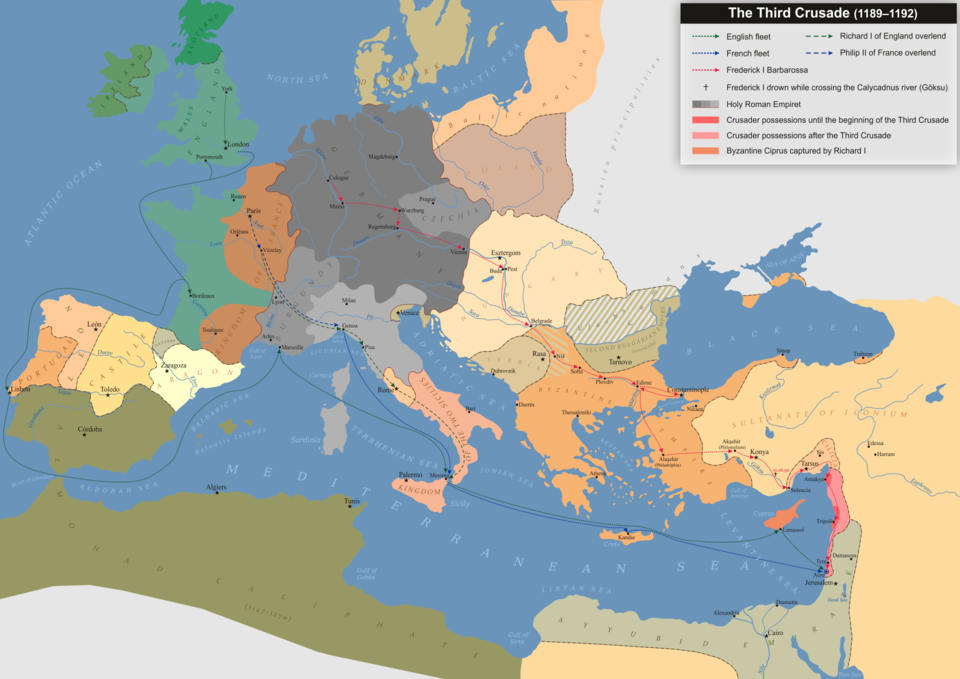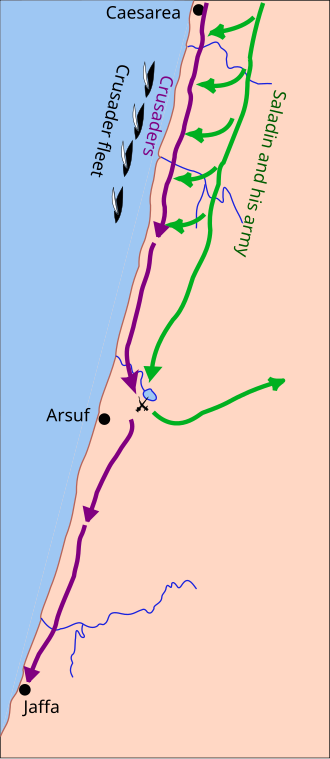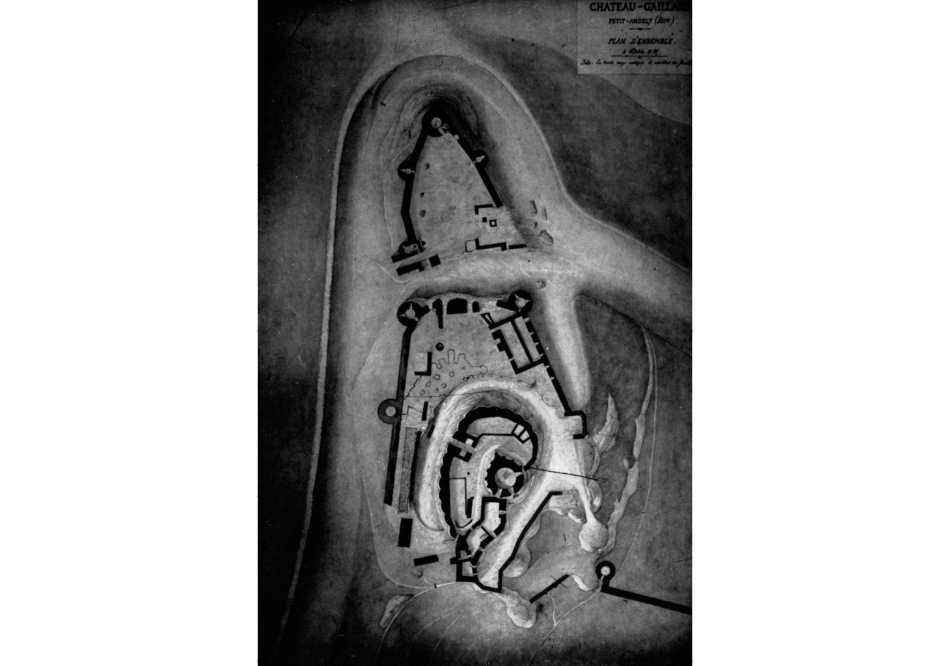IB Syllabus focus:
'Detailed accounts of Richard's significant military campaigns, including in Sicily, Cyprus, and during the Third Crusade, with attention to the objectives, strategies, key events, and outcomes of each.
The political and military context of his campaigns in France and their implications for the Angevin Empire.
The challenges and setbacks he faced, including his capture and the response to it.'
Richard I, also renowned as Richard the Lionheart, was famed for his military ventures which left an indelible mark on Europe and the Middle East during the late 12th century. His campaigns showcase his tactical brilliance, determination, and ambition.
Sicilian Campaign
Objective: Secure a passage to the Holy Land for the Third Crusade by establishing dominance over Sicily.
Background:
Tensions had escalated due to the disputed Sicilian crown following the death of William II of Sicily.
Richard’s sister, Joan, widow of William II, was held in Palermo by the new ruler, Tancred.
The Crusader army required a stable route through Sicily en route to the Holy Land.
Strategies:
Lay siege to strategic locations, particularly Messina, to exert pressure.
Utilise diplomacy to gain local support and isolate Tancred.
Key Events:
Siege of Messina (1190): The city resisted, but Richard's forces were superior in number and strategy, leading to a quick capitulation.
Treaty of Messina (1190): This diplomatic accord ensured Joan's release, a promise of marriage between Richard's nephew and Tancred's daughter, and affirmed the Crusaders' right to unhindered passage.
Outcomes: Richard successfully reasserted his family's influence in Sicily and guaranteed a safe passage for his forces.
Cyprus Campaign
Objective: Capture and utilise Cyprus as a logistical base for operations in the Holy Land.
Background:
The island was under the rule of the self-proclaimed emperor, Isaac Komnenos.
Richard's ship, carrying his fiancée Berengaria of Navarre, was shipwrecked on Cyprus, leading to a confrontation.
Strategies:
Rapid assaults on coastal cities to cut off potential reinforcements.
Form alliances with disgruntled local leaders against Isaac.
Key Events:
Capture of Limassol (1191): This strategic port city quickly fell to Richard, bolstering his position on the island.
Battle of Tremetousia (1191): Isaac's forces were decisively defeated, leading to his capture and exile.
Outcomes:
Richard brought Cyprus under direct Western feudal lordship, which proved invaluable for Crusader operations in the Holy Land.
Third Crusade
Objective: Retake Jerusalem and the Holy Land from Saladin’s Ayyubid Empire.
Background: The fall of Jerusalem in 1187 to Saladin was a significant blow to Christendom, triggering a fresh wave of crusading fervour.
Strategies:
Form a united front alongside other European monarchs, notably King Philip II of France.
Secure key coastal strongholds to ensure supply lines and staging areas.

This map locates the principal sites of the Third Crusade (1189–1192), including Acre, Arsuf, and Jaffa, clarifying why control of the coast was strategically decisive for supply and staging. It also traces the routes of the main crusading contingents, which, while broader than Richard’s own movements, frame the coalition nature of the campaign. Source
Key Events:
Siege of Acre (1189-1191): An extended confrontation where Richard showcased his skill in siege warfare, resulting in a major victory for the Crusaders.
Battle of Arsuf (1191): Richard's forces, employing heavy cavalry tactics, routed Saladin's army.
Diplomacy with Saladin (1192): Continuous negotiations culminated in the Treaty of Jaffa, which while maintaining Muslim control over Jerusalem, granted Christian pilgrims access.

This battle plan of Arsuf illustrates the Crusader column’s formation along the coast and the climactic cavalry charge that broke Saladin’s line. The clear labels for the Hospitallers, Templars, infantry, and reserves help explain how Richard coordinated shock action with disciplined control. Source
Outcomes:
The Third Crusade restored several coastal cities to Christian control but fell short of its primary goal—recapturing Jerusalem.
Campaigns in France
Objective: Safeguard and expand Angevin territories in France against the ascendant Capetian monarchy.
Background: The Angevin Empire's vast French territories were a constant source of tension with the French Crown, especially with the assertive Philip II.
Strategies:
Construct and renovate castles for defensive and administrative purposes.
Foster alliances with regional lords to form a bulwark against Capetian encroachment.
Key Events:
Battle of Freteval (1194): A notable Angevin victory where Richard intercepted and defeated a French force.
Construction of Château Gaillard (1196-1198): This fortress, built on the Seine, exemplified Richard's dedication to Angevin territorial integrity.

This nineteenth-century plan of Château Gaillard shows the inner keep and concentric baileys cut by dry moats, clarifying Richard’s emphasis on layered defense above the Seine. While the drawing includes technical detail beyond the syllabus (e.g., specific curtain-wall segments), it directly supports the fortress’s purpose and scale in Richard’s French strategy. Source
Outcomes:
Richard's campaigns stabilised Angevin control over key territories but failed to decisively curtail Philip II's ambitions.
Challenges and Setbacks
Capture and Ransom:
Background: During his return journey in 1192, Richard was apprehended near Vienna by Leopold V of Austria, later transferred to the custody of Henry VI, Holy Roman Emperor.
Details:
Richard's captivity was a political manoeuvre, capitalising on his vulnerability.
A vast ransom was set, amounting to 150,000 marks.
Response:
Efforts to gather the ransom were exhaustive, leading to heavy taxation and the selling of assets across Richard's domains.
Richard's release in 1194 was celebrated but had long-term financial implications for his territories.
The demanding ransom, alongside the expenses of his campaigns, placed tremendous economic strain upon Richard's subjects, fuelling discontent and affecting governance in his territories.
FAQ
Cyprus, given its strategic location, offered several advantages to Richard and the wider Crusader operations. Firstly, as a large island close to the mainland Levant, it served as a vital logistical hub for resupplying and reinforcing Crusader armies. Its ports and harbours facilitated the movement and shelter of naval vessels, crucial for the transportation of troops, provisions, and equipment. Secondly, with Cyprus under Crusader control, it acted as a buffer, reducing the threat of naval attacks or blockades from Muslim forces. Lastly, its acquisition showcased Richard's authority and military prowess, serving as a morale boost for his forces and allies.
While the primary impetus behind constructing Château Gaillard was defensive, its significance transcended mere military functionality. Strategically situated on the Seine, it guarded the vital river route to Rouen, the capital of Normandy, effectively barring Philip II's path. Architecturally, Château Gaillard was a masterpiece, showcasing the latest advancements in military design, reinforcing Richard's image as a cutting-edge military leader. Additionally, the fortress acted as a symbol of Angevin dominance, an assertion of Richard's claim over the territories. It wasn't just a defence against external threats; it was a bold statement of power, ambition, and authority.
Coastal cities held prime strategic importance during the Third Crusade due to several reasons. They provided vital ports, facilitating naval resupply and reinforcements—key elements for a Crusader army that heavily depended on resources from Europe. Additionally, controlling coastal cities like Acre acted as a springboard for further inland campaigns. Lastly, these cities had economic significance, offering trade opportunities that could finance the crusading efforts. By focusing on these cities, the Crusaders were able to establish a firm foothold in the region, facilitating subsequent inland advances. While this strategy did bolster their position, the broader objective of recapturing Jerusalem remained elusive, indicating that while coastal dominance was crucial, it wasn't the sole determinant of success.
Yes, the imposition of heavy taxation to amass Richard's ransom had far-reaching repercussions in England. The financial burden was deeply felt by both nobles and commoners, leading to widespread discontent. This strain was exacerbated by the pre-existing economic demands of Richard's extensive military campaigns. Many perceived Richard as prioritising his overseas ventures over domestic governance. The resentment sown during this period would later manifest in conflicts and tensions between the crown and the nobility. The situation laid groundwork for future disputes over royal prerogatives, taxation, and the rights of subjects, contributing to the evolving dynamics of medieval English governance.
The Sicilian campaign was not a mere detour for Richard but rather a strategic move considering the broader geopolitical context. With the death of William II of Sicily, there was an ensuing power vacuum and the rise of Tancred threatened the Angevin interests in the region. Furthermore, Richard's sister Joan was held in Palermo, presenting a personal motive. Engaging in the Sicilian campaign allowed Richard to secure a strategic route and base for his crusader forces to move onto the Holy Land. By ensuring stability and securing favourable terms in Sicily, Richard positioned himself and his forces in a stronger stance to pursue the primary objectives in the Holy Land.
Practice Questions
Richard I's campaigns in Sicily and Cyprus played pivotal roles in achieving broader objectives of the Third Crusade. In Sicily, Richard secured a strategic route through to the Holy Land, ensuring safe passage for Crusader forces. This venture not only reasserted Angevin influence but also ensured logistical preparedness. The acquisition of Cyprus was equally significant. Its capture provided a logistical base close to the Holy Land, facilitating supply lines and reinforcements. Whilst the Third Crusade did not achieve its primary goal of recapturing Jerusalem, the foundations set by Richard's early campaigns in Sicily and Cyprus maximised the potential for success.
Richard's capture and the subsequent ransom demand posed profound challenges to the Angevin Empire's stability and economy. The astronomical sum of 150,000 marks placed enormous strain on the treasury. To raise this sum, extensive taxation was levied, assets were sold, and church wealth was borrowed. Such measures fostered discontent among the populace and nobility alike, potentially undermining the empire's internal cohesion. Economically, the Angevin territories were drained, causing hardships that lingered long after Richard's release. While his release in 1194 was celebrated, the economic repercussions, coupled with the emerging political instability, hinted at deeper vulnerabilities within the Angevin framework.

